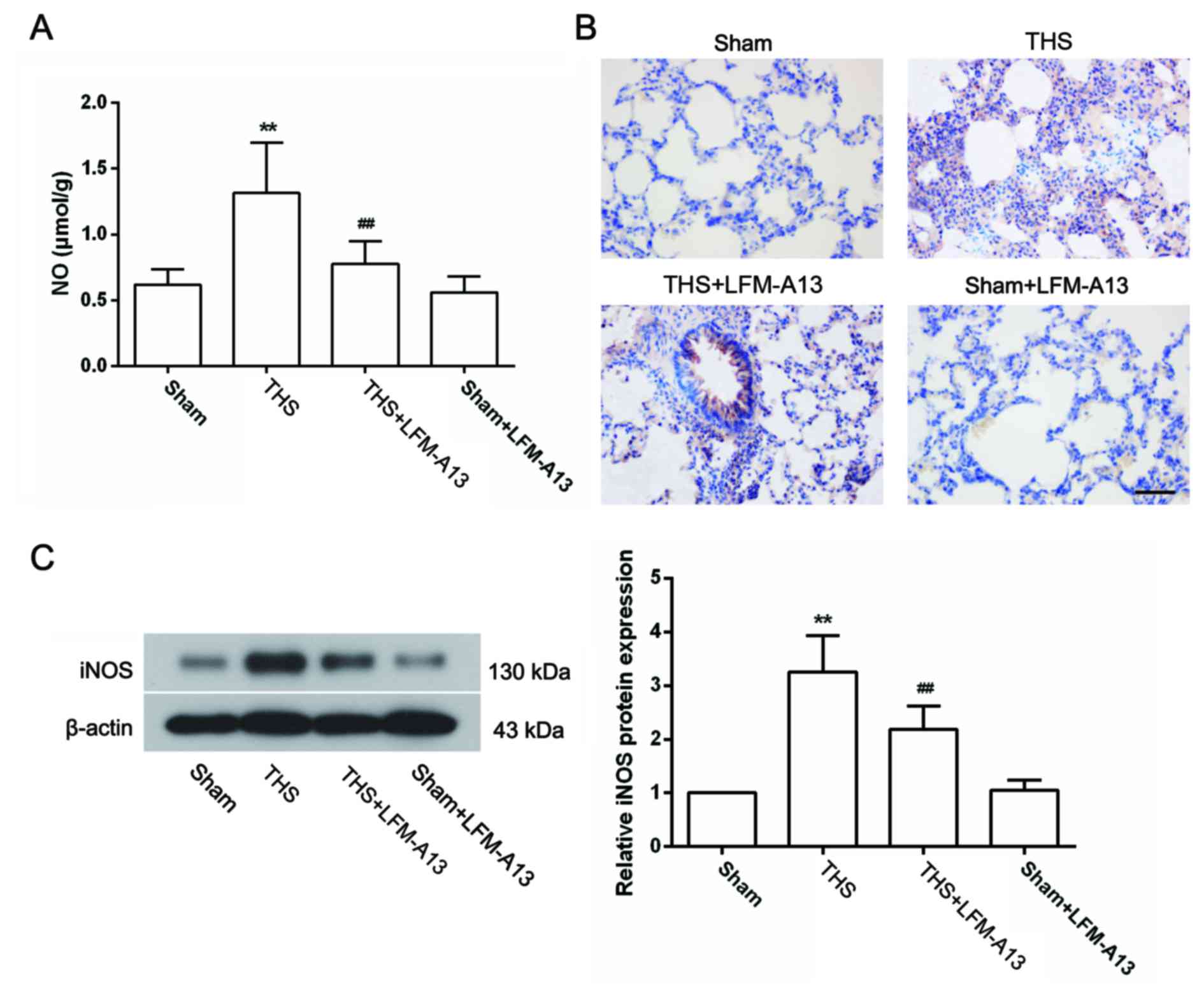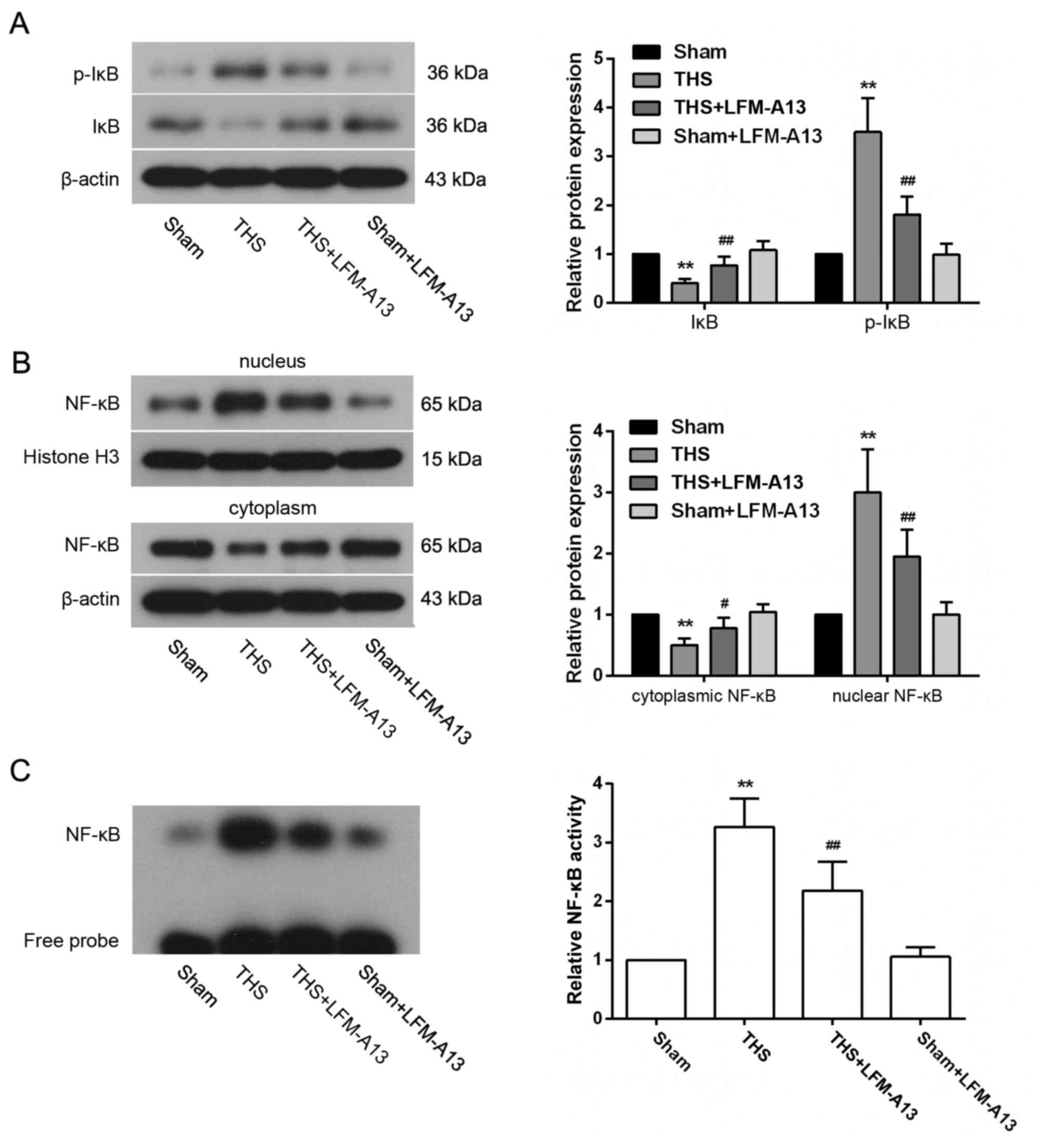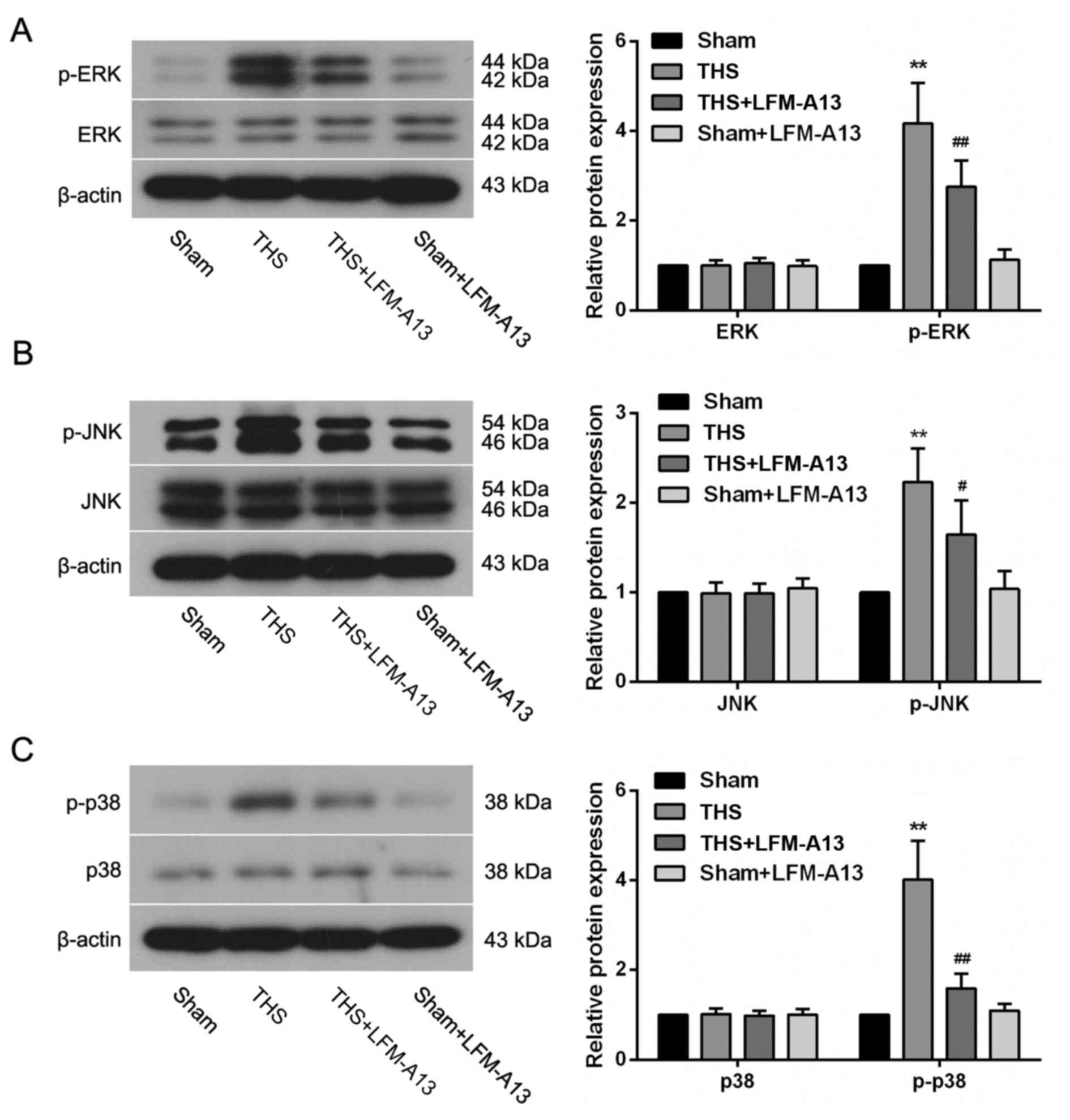|
1
|
Kauvar DS, Lefering R and Wade CE: Impact
of hemorrhage on trauma outcome: An overview of epidemiology,
clinical presentations, and therapeutic considerations. J Trauma.
60:(6 Suppl). S3–S11. 2006. View Article : Google Scholar : PubMed/NCBI
|
|
2
|
Kauvar DS and Wade CE: The epidemiology
and modern management of traumatic hemorrhage: US and international
perspectives. Crit Care. 9:(Suppl 5). S1–S9. 2005. View Article : Google Scholar : PubMed/NCBI
|
|
3
|
Angele MK, Schneider CP and Chaudry IH:
Bench-to-bedside review: Latest results in hemorrhagic shock. Crit
Care. 12:2182008. View
Article : Google Scholar : PubMed/NCBI
|
|
4
|
Cai B, Deitch EA and Ulloa L: Novel
insights for systemic inflammation in sepsis and hemorrhage.
Mediators Inflamm. 2010:6424622010. View Article : Google Scholar : PubMed/NCBI
|
|
5
|
Lee CC, Chang IJ, Yen ZS, Hsu CY, Chen SY,
Su CP, Chiang WC, Chen SC and Chen WJ: Delayed fluid resuscitation
in hemorrhagic shock induces proinflammatory cytokine response. Ann
Emerg Med. 49:37–44. 2007. View Article : Google Scholar : PubMed/NCBI
|
|
6
|
Claridge JA, Schulman AM and Young JS:
Improved resuscitation minimizes respiratory dysfunction and blunts
interleukin-6 and nuclear factor-kappa B activation after traumatic
hemorrhage. Crit Care Med. 30:1815–1819. 2002. View Article : Google Scholar : PubMed/NCBI
|
|
7
|
Jiang H, Huang Y, Xu H, Hu R and Li QF:
Inhibition of hypoxia inducible factor-1α ameliorates lung injury
induced by trauma and hemorrhagic shock in rats. Acta Pharmacol
Sin. 33:635–643. 2012. View Article : Google Scholar : PubMed/NCBI
|
|
8
|
Koscsó B, Trepakov A, Csóka B, Németh ZH,
Pacher P, Eltzschig HK and Haskó G: Stimulation of A2B adenosine
receptors protects against trauma-hemorrhagic shock-induced lung
injury. Purinergic Signal. 9:427–432. 2013. View Article : Google Scholar : PubMed/NCBI
|
|
9
|
Yang WC, Collette Y, Nunès JA and Olive D:
Tec kinases: A family with multiple roles in immunity. Immunity.
12:373–382. 2000. View Article : Google Scholar : PubMed/NCBI
|
|
10
|
Mohamed AJ, Yu L, Bäckesjö CM, Vargas L,
Faryal R, Aints A, Christensson B, Berglöf A, Vihinen M, Nore BF
and Smith CI: Bruton's tyrosine kinase (Btk): Function, regulation,
and transformation with special emphasis on the PH domain. Immunol
Rev. 228:58–73. 2009. View Article : Google Scholar : PubMed/NCBI
|
|
11
|
Jefferies CA and O'Neill LA: Bruton's
tyrosine kinase (Btk)-the critical tyrosine kinase in LPS
signalling? Immunol Lett. 92:15–22. 2004. View Article : Google Scholar : PubMed/NCBI
|
|
12
|
Fluckiger AC, Li Z, Kato RM, Wahl MI, Ochs
HD, Longnecker R, Kinet JP, Witte ON, Scharenberg AM and Rawlings
DJ: Btk/Tec kinases regulate sustained increases in intracellular
Ca2+ following B-cell receptor activation. EMBO J. 17:1973–1985.
1998. View Article : Google Scholar : PubMed/NCBI
|
|
13
|
Turner H and Kinet JP: Signalling through
the high-affinity IgE receptor Fc epsilonRI. Nature. 402:(6760
Suppl). B24–B30. 1999. View
Article : Google Scholar : PubMed/NCBI
|
|
14
|
Bajpai UD, Zhang K, Teutsch M, Sen R and
Wortis HH: Bruton's tyrosine kinase links the B cell receptor to
nuclear factor kappaB activation. J Exp Med. 191:1735–1744. 2000.
View Article : Google Scholar : PubMed/NCBI
|
|
15
|
Qiu Y and Kung HJ: Signaling network of
the Btk family kinases. Oncogene. 19:5651–5661. 2000. View Article : Google Scholar : PubMed/NCBI
|
|
16
|
Lindvall J and Islam TC: Interaction of
Btk and Akt in B cell signaling. Biochem Biophys Res Commun.
293:1319–1326. 2002. View Article : Google Scholar : PubMed/NCBI
|
|
17
|
Mueller H, Stadtmann A, Van Aken H, Hirsch
E, Wang D, Ley K and Zarbock A: Tyrosine kinase Btk regulates
E-selectin-mediated integrin activation and neutrophil recruitment
by controlling phospholipase C (PLC) gamma2 and PI3Kgamma pathways.
Blood. 115:3118–3127. 2010. View Article : Google Scholar : PubMed/NCBI
|
|
18
|
Sakuma C, Sato M, Takenouchi T, Chiba J
and Kitani H: Critical roles of the WASP N-terminal domain and Btk
in LPS-induced inflammatory response in macrophages. PLoS One.
7:e303512012. View Article : Google Scholar : PubMed/NCBI
|
|
19
|
Kutsch N, Marks R, Ratei R, Held TK and
Schmidt-Hieber M: Role of tyrosine kinase inhibitors in indolent
and other mature B-Cell neoplasms. Biomark Insights. 10:(Suppl 3).
S15–S23. 2015.
|
|
20
|
de Rooij MF, Kuil A, Geest CR, Eldering E,
Chang BY, Buggy JJ, Pals ST and Spaargaren M: The clinically active
BTK inhibitor PCI-32765 targets B-cell receptor- and
chemokine-controlled adhesion and migration in chronic lymphocytic
leukemia. Blood. 119:2590–2594. 2012. View Article : Google Scholar : PubMed/NCBI
|
|
21
|
Di Paolo JA, Huang T, Balazs M, Barbosa J,
Barck KH, Bravo BJ, Carano RA, Darrow J, Davies DR, DeForge LE, et
al: Specific Btk inhibition suppresses B cell- and myeloid
cell-mediated arthritis. Nat Chem Biol. 7:41–50. 2011. View Article : Google Scholar : PubMed/NCBI
|
|
22
|
Akinleye A, Chen Y, Mukhi N, Song Y and
Liu D: Ibrutinib and novel BTK inhibitors in clinical development.
J Hematol Oncol. 6:592013. View Article : Google Scholar : PubMed/NCBI
|
|
23
|
Honigberg LA, Smith AM, Sirisawad M,
Verner E, Loury D, Chang B, Li S, Pan Z, Thamm DH, Miller RA and
Buggy JJ: The Bruton tyrosine kinase inhibitor PCI-32765 blocks
B-cell activation and is efficacious in models of autoimmune
disease and B-cell malignancy. Proc Natl Acad Sci USA.
107:13075–13080. 2010. View Article : Google Scholar : PubMed/NCBI
|
|
24
|
Lai EW, Toledo-Pereyra LH, Walsh J,
Lopez-Neblina F and Anaya-Prado R: The role of MAP kinases in
trauma and ischemia-reperfusion. J Invest Surg. 17:45–53. 2004.
View Article : Google Scholar : PubMed/NCBI
|
|
25
|
Jarrar D, Chaudry IH and Wang P: Organ
dysfunction following hemorrhage and sepsis: Mechanisms and
therapeutic approaches (Review). Int J Mol Med. 4:575–583.
1999.PubMed/NCBI
|
|
26
|
Kiang JG, Agravante NG, Smith JT and
Bowman PD: 17-DMAG diminishes hemorrhage-induced small intestine
injury by elevating Bcl-2 protein and inhibiting iNOS pathway,
TNF-α increase, and caspase-3 activation. Cell Biosci. 1:212011.
View Article : Google Scholar : PubMed/NCBI
|
|
27
|
Levy G, Fishman JE, Xu DZ, Dong W, Palange
D, Vida G, Mohr A, Ulloa L and Deitch EA: Vagal nerve stimulation
modulates gut injury and lung permeability in trauma-hemorrhagic
shock. J Trauma Acute Care Surg. 73:338–342. 2012. View Article : Google Scholar : PubMed/NCBI
|
|
28
|
Menzel CL, Sun Q, Loughran PA, Pape HC,
Billiar TR and Scott MJ: Caspase-1 is hepatoprotective during
trauma and hemorrhagic shock by reducing liver injury and
inflammation. Mol Med. 17:1031–1038. 2011. View Article : Google Scholar : PubMed/NCBI
|
|
29
|
Hierholzer C, Harbrecht B, Menezes JM,
Kane J, MacMicking J, Nathan CF, Peitzman AB, Billiar TR and
Tweardy DJ: Essential role of induced nitric oxide in the
initiation of the inflammatory response after hemorrhagic shock. J
Exp Med. 187:917–928. 1998. View Article : Google Scholar : PubMed/NCBI
|
|
30
|
Desiderio S: Role of Btk in B cell
development and signaling. Curr Opin Immunol. 9:534–540. 1997.
View Article : Google Scholar : PubMed/NCBI
|
|
31
|
Horwood NJ, Mahon T, McDaid JP, Campbell
J, Mano H, Brennan FM, Webster D and Foxwell BM: Bruton's tyrosine
kinase is required for lipopolysaccharide-induced tumor necrosis
factor alpha production. J Exp Med. 197:1603–1611. 2003. View Article : Google Scholar : PubMed/NCBI
|
|
32
|
Zhou P, Ma B, Xu S, Zhang S, Tang H, Zhu
S, Xiao S, Ben D and Xia Z: Knockdown of Burton's tyrosine kinase
confers potent protection against sepsis-induced acute lung injury.
Cell Biochem Biophys. 70:1265–1275. 2014. View Article : Google Scholar : PubMed/NCBI
|
|
33
|
Krupa A, Fol M, Rahman M, Stokes KY,
Florence JM, Leskov IL, Khoretonenko MV, Matthay MA, Liu KD, Calfee
CS, et al: Silencing Bruton's tyrosine kinase in alveolar
neutrophils protects mice from LPS/immune complex-induced acute
lung injury. Am J Physiol Lung Cell Mol Physiol. 307:L435–L448.
2014. View Article : Google Scholar : PubMed/NCBI
|
|
34
|
Olanders K, Sun Z, Börjesson A, Dib M,
Andersson E, Lasson A, Ohlsson T and Andersson R: The effect of
intestinal ischemia and reperfusion injury on ICAM-1 expression,
endothelial barrier function, neutrophil tissue influx, and
protease inhibitor levels in rats. Shock. 18:86–92. 2002.
View Article : Google Scholar : PubMed/NCBI
|
|
35
|
Kao MC, Yang CH, Sheu JR and Huang CJ:
Cepharanthine mitigates pro-inflammatory cytokine response in lung
injury induced by hemorrhagic shock/resuscitation in rats.
Cytokine. 76:442–448. 2015. View Article : Google Scholar : PubMed/NCBI
|
|
36
|
Ding R, Han J, Tian Y, Guo R and Ma X:
Sphingosine-1-phosphate attenuates lung injury induced by
intestinal ischemia/reperfusion in mice: Role of inducible
nitric-oxide synthase. Inflammation. 35:158–166. 2012. View Article : Google Scholar : PubMed/NCBI
|
|
37
|
Hierholzer C, Harbrecht BG, Billiar TR and
Tweardy DJ: Hypoxia-inducible factor-1 activation and
cyclo-oxygenase-2 induction are early reperfusion-independent
inflammatory events in hemorrhagic shock. Arch Orthop Trauma Surg.
121:219–222. 2001. View Article : Google Scholar : PubMed/NCBI
|
|
38
|
Ishii H, Ishibashi M, Takayama M, Nishida
T and Yoshida M: The role of cytokine-induced neutrophil
chemoattractant-1 in neutrophil-mediated remote lung injury after
intestinal ischaemia/reperfusion in rats. Respirology. 5:325–331.
2000. View Article : Google Scholar : PubMed/NCBI
|
|
39
|
Cabrales P, Tsai AG and Intaglietta M:
Exogenous nitric oxide induces protection during hemorrhagic shock.
Resuscitation. 80:707–712. 2009. View Article : Google Scholar : PubMed/NCBI
|
|
40
|
Szabo C and Billiar TR: Novel roles of
nitric oxide in hemorrhagic shock. Shock. 12:1–9. 1999. View Article : Google Scholar : PubMed/NCBI
|
|
41
|
Collins JL, Vodovotz Y, Hierholzer C,
Villavicencio RT, Liu S, Alber S, Gallo D, Stolz DB, Watkins SC,
Godfrey A, et al: Characterization of the expression of inducible
nitric oxide synthase in rat and human liver during hemorrhagic
shock. Shock. 19:117–122. 2003. View Article : Google Scholar : PubMed/NCBI
|
|
42
|
Partrick DA, Moore FA, Moore EE, Barnett
CC Jr and Silliman CC: Neutrophil priming and activation in the
pathogenesis of postinjury multiple organ failure. New Horiz.
4:194–210. 1996.PubMed/NCBI
|
|
43
|
Botha AJ, Moore FA, Moore EE, Kim FJ,
Banerjee A and Peterson VM: Postinjury neutrophil priming and
activation: An early vulnerable window. Surgery. 118:358–365. 1995.
View Article : Google Scholar : PubMed/NCBI
|
|
44
|
Jeong KY, Suh GJ, Kwon WY, Kim KS, Jung YS
and Kye YC: The therapeutic effect and mechanism of niacin on acute
lung injury in a rat model of hemorrhagic shock: Down-regulation of
the reactive oxygen species-dependent nuclear factor κB pathway. J
Trauma Acute Care Surg. 79:247–255. 2015. View Article : Google Scholar : PubMed/NCBI
|
|
45
|
Kochanek AR, Fukudome EY, Li Y, Smith EJ,
Liu B, Velmahos GC, deMoya M, King D and Alam HB: Histone
deacetylase inhibitor treatment attenuates MAP kinase pathway
activation and pulmonary inflammation following hemorrhagic shock
in a rodent model. J Surg Res. 176:185–194. 2012. View Article : Google Scholar : PubMed/NCBI
|
|
46
|
Jefferies CA, Doyle S, Brunner C, Dunne A,
Brint E, Wietek C, Walch E, Wirth T and O'Neill LA: Bruton's
tyrosine kinase is a Toll/interleukin-1 receptor domain-binding
protein that participates in nuclear factor kappaB activation by
Toll-like receptor 4. J Biol Chem. 278:26258–26264. 2003.
View Article : Google Scholar : PubMed/NCBI
|
|
47
|
Lee KG, Xu S, Kang ZH, Huo J, Huang M, Liu
D, Takeuchi O, Akira S and Lam KP: Bruton's tyrosine kinase
phosphorylates Toll-like receptor 3 to initiate antiviral response.
Proc Natl Acad Sci USA. 109:5791–5796. 2012. View Article : Google Scholar : PubMed/NCBI
|
















